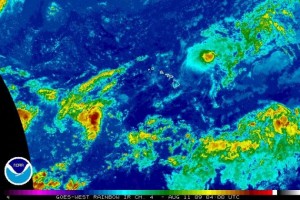Forecast calls for up to three Tropical Cyclones this Hurricane Season
The Central Pacific Hurricane Center expects a below normal season with two to three tropical cyclones in the Central Pacific this year. An average season has four or five tropical cyclones, which includes tropical depressions, tropical storms and hurricanes. Despite the outlook for less activity, forecasters remind the public to take each tropical system seriously. Last year, Hurricane Felicia approached the islands, but dissipated before causing any significant impacts. The Central Pacific Hurricane Center runs from June 1 to November 30, 2010.

(In August 2009, Hurricane Felicia was on track toward the islands before the system dissipated into a tropical storm) Satellite imagery courtesy NOAA & The National Hurricane Center. Image updated at 6p hst 8/10/09)
Jim Weyman, director of NOAA’s Central Pacific Hurricane Center said this year’s message is: Prepare, Watch, and Act! “Now is the time to dust off those family emergency plans, continue to monitor conditions throughout the hurricane season, and take appropriate action when a hurricane threatens,” said Wyman.
Historically, hurricanes have cost the state of Hawaii more money than any other natural disaster. Since 1959, 63 hurricanes, 49 tropical storms and 58 tropical depressions have occurred in the Central Pacific. In 1992, Hurricane Iniki left a trail of social and economic impacts, especially on the island of Kauai.
For 2010, the outlook calls for a 70% chance of a below normal season, a 25% chance of a near normal season, and only a 5% chance of an above normal season. Climate patterns similar to those expected this year have historically produced below normal activity in the central Pacific.
The outlook is based on two climate factors, the first being the ongoing low-activity era in the central Pacific, which partly reflects fewer eastern Pacific hurricanes moving into the region. The second factor is the expectation of either ENSO-neutral or La Niña conditions in the equatorial Pacific, neither of which favors tropical cyclone activity in the central Pacific. These factors have historically produced below normal seasons.
The outlook is a general guide to the overall seasonal hurricane activity and does not predict whether, where, when, or how many any of these systems will affect Hawaii.
NOAA’s Central Pacific Hurricane Center calls in additional staff meteorologists when a system forms to continuously monitor weather conditions, employing a dense network of satellites, land- and ocean-based sensors and aircraft reconnaissance missions operated by NOAA and its partners. This array of data supplies the information for complex computer modeling and human expertise that serves as the basis for the hurricane center’s track and intensity forecasts that extend out five days.
Hawaii Governor Linda Lingle proclaimed May 24-30, 2010 as Hurricane Preparedness Week in the state of Hawaii.
(Posted by Wendy Osher; Supporting information courtesy the National Oceanic and Atmospheric Administration & Hawaii Office of the Governor)










